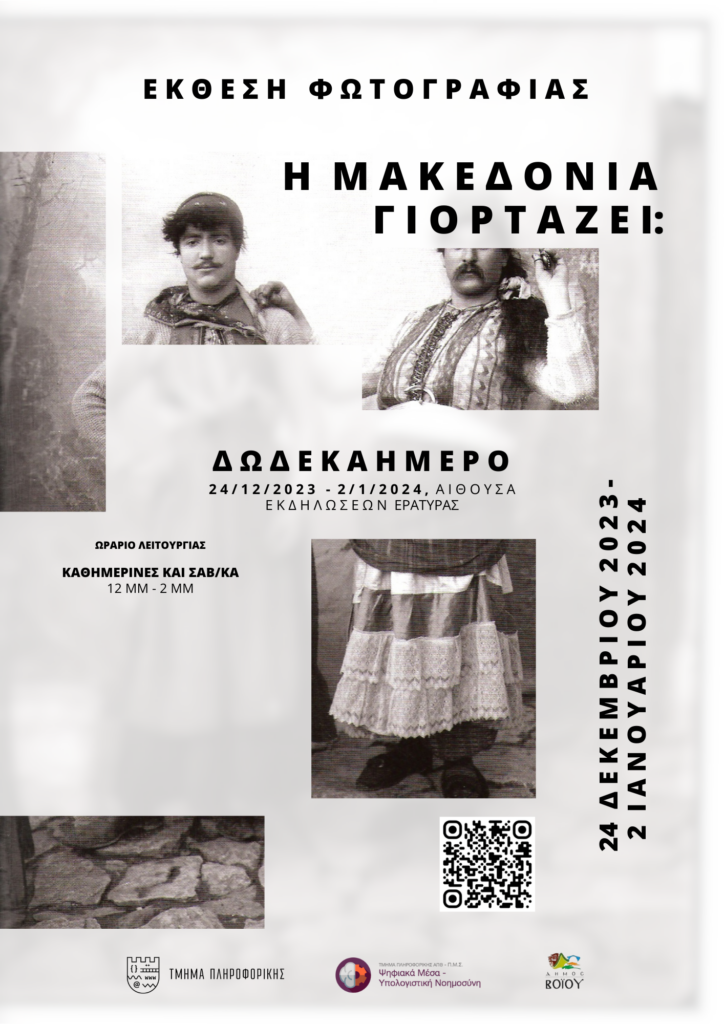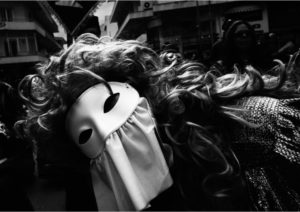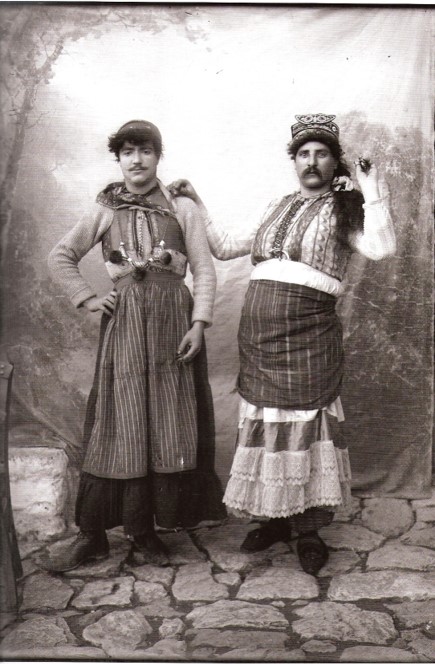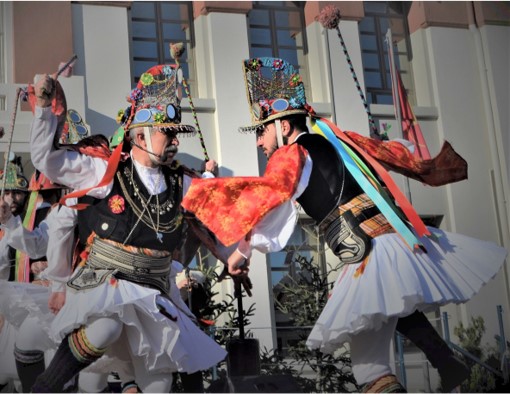Photography Exhibition
“MACEDONIA CELEBRATES”
The physical photography exhibition entitled “Macedonia Celebrates” will take place from 24 December 2023 to 2 January 2024 at the community of Eratyra in Kozani.
Exhibition location: Cultural Events Hall of the Eratyra Community.
Operating hours: 12pm – 2pm
24 December 2023 – 2 January 2024 in Eratyra, Kozani
Digital Photo e-Exhibition “Macedonia Celebrates”
Many thanks to the photographers who contributed with their material (I hope I haven’t forgotten anyone), to the contributors of the exhibition and to the postgraduate students of the MSc in Digital Media-Computational Intelligence of the Department of Computer Science of the Aristotle University of Thessaloniki who curated the exhibition.
Happy holidays.
Dodecameron and Lent festivities, and carnivals
In most towns and villages of Macedonia, brass-band music is ubiquitous during the entire Dodecameron, as brass bands entertain carnival troupes and bystanders alike. Hear characteristic tunes in: https://www.youtube.com/watch?v=OHDLBX83p2E
Almost all these Dodecameron celebrations are both public and private events and excuses for day- and night-long partying; the carnival troupes party in city squares, streets or in cafes, but then retire and continue partying at homes until early hours. Visitors are very welcomed to blend into these celebrations.
Winter solstice celebrations are very old and cover a wide arc of countries, from Scotland and Scandinavia to S.E. Europe, Iran and India Dodecameron festivities. In Orthodox countries, notably in S.E. Europe (e.g., Greece) the core festivities (Dodecameron) last for twelve days, from Christmas Eve (24th December) till Epiphany day ( 6th January). The roots of the customs are lost in Antiquity, perhaps in the worship of Dionysus, maybe even earlier, in proto indo-european pagan rituals. Dodecameron coincides with the winter solstice (21 December), which naturally caused awe to our distant ancestors, when they saw the unexplainable declining course of the winter sun. It made sense, then, to appease the Sun god with festivals. Moreover, all agricultural pursuits were in hibernation, while cellars were still full of goods. From ancient times to the present day, pig slaughter has always taken place in December, simply because that is when the pigs were at their optimum weight and fat, and there was no longer any food for their further preservation. Pork meat in various forms (e.g., tasty sausages) is abundant during the entire Dodecameron. New wine and spirits (e.g. raki, tsipouro) just come out of the vats.
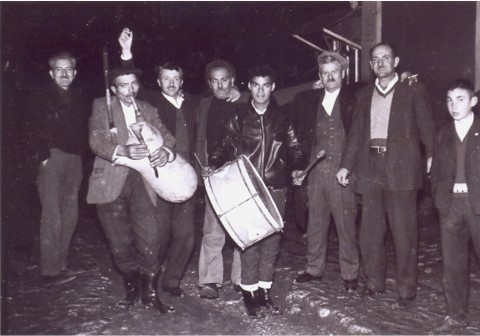
Since Antiquity, there were plenty of opportunities for joy and matchmaking: January was the month of weddings in Ancient Greece. The Romans came with their festivals (Brumalia 24/11-17/12, Saturnalia/Kronia (18-24/12), Sol Invictus (Invincible Sun, 25/12, Kalends 1/1, Vota 3/1, Lorentalia 4/1), gave the name January to the 1st month of the year and completed the first version of Dodecameron festivities. Romans inherited us Calendae (Kalanda), namely Carols on Christmas eve or New Year eve. Originally, such Carols were merry songs that had nothing to do with Christianity.
Hence, several Dodecameron customs are reminiscent of, if not directly related to, pre-Christian customs. Bonfires play a big role in winter solistice and Dodecameron celebrations: they both warm and exorcise the sun, which first sets (until the winter solstice on 21 December) and then rises again. Zoomorphic carnivals are at their best and merry songs are heard everywhere. Carols seems to have been sung in Roman times, in exchange for gifts and drink. On New Year’s Day, the Romans exchanged gifts, e.g., honey and figs, which were symbols of happiness and abundance. On the occasion of the festivals, they decorated their temples every December. Vikings and Saxons decorated trees, and considered them symbols of life. Many ancient sun-related gods or demigods were ‘born’ on the winter solstice, when the day actually begins to grow longer: Dionysus, Hermes, Hercules (Greece), Horus (Egypt), Zarathustra, Mithras (Persia), Krishna (India), Buddha (Nepal), Adonis (Phoenicia), and Tamuz (Babylon).
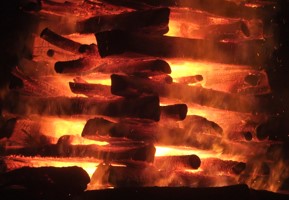
Christianity put its own stamp on Dodecameron, giving it its present form. The date of Jesus’ birth on 25/12 was a historically and culturally expected natural choice. Already in the middle of the 4th century AD, the then united church set Christmas on 25/12, exactly on the feast of the Invincible Sun. The Eastern Romans (Byzantines) gave a new Christian mantle to the old pagan customs. The bonfires of the winter solstice were renamed the fires of the shepherds who attended the birth of Jesus. New Christian Carols were created or the old ones were supplemented with Christian elements, and the Dodecameron came into its present form. All Dodecameron festivities were condemned by the Christian church, but survived.
Current Dodecameron festivities are multilayered events, with deep pagan, Christian and modern consumer layers. Today, they are celebrated at their best in Western Macedonia, Greece, for historical reasons: they survived intact due to the geographical isolation of this region. The festive atmosphere begins around the feast of St. Nicholas (6/12) and continues unabated beyond Dodecameron and well into Lent carnivals. Christmas and new year bonfires are lit in Siatista and Florina (23/12) and in Almopia (30/12). Various colorful carnivals are alive and well: Boubousaria carnivals are celebrated in Galatini (1/1), Eratyra (2/1) and in Siatista (5/1). Ragoutsaria carnivals (perhaps coming from the Roman rogatores-beggers) are a three day riotous celebrations in Kastoria (6-8/1). Their satirical character can sometimes become libertine, tempting the faithful. The celebrations are complemented by the bell-bearer carnivals on Epiphany day (5/1) in Eastern Macedonia, Greece (Babouyera in Kali Vrysi, Arapides in Nikisiani, Monastiraki, Xiropotamos, Volakas). They showcase impressive costumes and have some similarities with bell-bearer carnivals in Bulgaria and N. Macedonia. Throughout Dodecameron, Pontian Greeks celebrate Momorgeri carnivals with colorful costumes and lyra dances in various places all over Macedonia (Alonakia, Agios Dimitrios, Asvestopetra, Karyochori, Komnina, Protochori, Skiti, Tetralofos, Mesopotamia, Platanias, Sitagri). Many Dodecameron carnival pictures can be found in the digital photo e-exhibition.
Almost all these Dodecameron celebrations are both public and private events and excuses for day- and night-long partying; the carnival troupes party in city squares, streets or in cafes, but then retire and continue partying at homes until early hours. Visitros are very welcomed to blend into these celebrations.
In the northern hemisphere, winter solstice celebrations take place in almost all indo-european nations. During the winter solstice, Slavs celebrate the pre-Christian Korochun or Kolyada or Koleda. As early as the first centuries AD, the celebration of St. Nicholas, as the patron saint of needy daughters and benefactor of the poor, spread throughout Christendom. St. Nicholas day (St Mikuláš day, St. Nicholasday) is one of the few saints’ feasts that, to this day, are celebrated on the same day of the year (6th December) by various Christian denominations (Orthodox, Catholic and Protestant Churches). In Orthodox countries, this feast marks the beginning of the festive season leading up to Dodecameron. Especially in the West, St. Nicholas became a benevolent old man, who gives gifts to children. This tradition is strong in the Netherlands, where Sinterklaas, and his Negro assistant ZwartePiet, distribute gifts to children. It is said that, during the Reformation, Luther tried to transfer this custom to Christmas. This post-dating succeeded in many countries much later, thanks to Coca Cola, which, in the 1930s, launched, with great success, Santa Claus (a corruption of Sankt Nikolaus), the kindly old man who distributes gifts (preferably Coca Colas) at Christmas. In Greece, Santa Claus was subsequently blended with Saint Basil (Ai Vasilis), a venerable Orthodox saint celebrated on the 1st of January. This rapid customs transfiguration in our times, almost within the confines of a single human generation, is a really striking cultural phenomenon.In Central and Eastern Macedonia, Lent celebrations tend to be rather modest, but are strikingly beautiful. The bell-bearers of Sohos wear fantastic head masks. The bells and goat-like costumes of Babougeroi (Vamvakofyto, Flambouro, Serres) are highly impressive. Boules and Jennissaries carnivals of Naoussa, dressed in distinctive masks and costumes, dance to the accompaniment of special, local music performed with zournades (a type of musical instrument). In these practices, there seems to be some deep historical connection with the Ottoman period. In performing Lent carnivals in this way, the elements of tradition that constitute the historical consciousness of the Greeks are preserved unchanged.
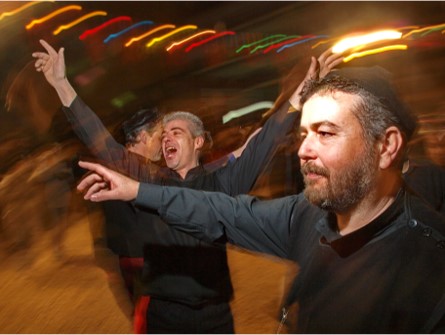
The Lent Carnival season is celebrated in many other parts of Greece as well, but in a different way, as the prevalent trends strongly exhibit Western influences, aiming to emulate the glory of Rio or Venice Carnivals. However, they all retain elements of authenticity and offer moments of joy and opportunities for singing, dancing, and revelry.
Of course, Greeks are not the only ones celebrating Lent Carnival. The entire Christian world, from Eastern Europe to Latin America, revels in Carnivals well up to the beginning of Lent.
Winter solstice and Dodecameron festivities are spread over an arc starting in Scotland and Scandinavia in the north, passing through Central Europe and the Balkans and, via Iran, ending in Northern India. Everything revolves around similar themes: outdoor bonfires, bell-bearing and zoomorphic carnivals or disguises in the opposite sex. Big logs are put in the fireplace (‘koliantas’, ‘yulelog’, ‘butuculcrăciunului’). In particular, Western European celebrations have borrowed many elements from the Scandinavian Yule celebrations (from the Indo-European hjul meaning wheel). The celebration of St. Brigid in Ireland (February 1), the patron saint of the agricultural production of the New Year (milk and butter for this country), has similarities with the celebration of Orthodox St. Tryfon, protector of farmers. In Chester, England, Roman Saturnalia are still celebrated every 14th of December. India has three related festivals: Diwali festival (mid-September to mid-November) is dedicated to the victory of light over darkness; Lohri fires are lit in North India each January; and the Holi fires are lit throughout India, marking the beginning of spring and celebrating the upcoming new harvest (late February to mid-March, according to the Indian calendar). This geographical dispersion and thematic affinity indicates that these customs are ancient and possibly paleo-Indo-European. This hypothesis is reinforced by the fact that there are no significant winter solstice carnival events neither in Hungary nor in Finland (the only European countries with non-Indo-European populations), nor in Turkish or Arab nations in the Middle East.
Dodcameron events in Greece
0. December events
Chiri-Varvara (Τσιρι-Βάρβαρα): Amyntaio, 3 December
Bells: the nights of December in many villages of W. Macedonia
Gurnochares: Impromptu or organized feasts related to the slaughter of the pig, in many villages of Western Macedonia, in the days before/around Christmas.
1. Dodecameron Western Macedonia is the focus of the events of the Dodecameron. They are divided into the following time units:
A) Kolada – Christmas bonfires on 23/12 (Florina, Kastoria, Voio),
B) Surva – Boubousaria – New Year’s Carnival (30/12-2/1 and 5-6/1) in Voio and partly in Kastoria.
C) Epiphany (‘Phota’) (6-8/1) in Siatista and Kastoria
D) Momogeri, pontian custom mainly in villages of Kozani (Alonakia, Ag. Dimitrios, Asvestopetra, Karyochori, Komnina, Protochori, Skiti, Tetralofos, Mesopotamia, Platanias, Sitagri) on different dates throughout the Dodecameron. It is listed in the UNESCO World Heritage List.
Programme of events of the Dodecameron in Western Macedonia:
1.1 Christmas
23/12: At night Kolada in Siatista, Eratyra, Galatini, Vlasti, Kardia and multiple cities and villages of Western Macedonia.
23/12: At night Kladares (bonfires) in Siatista and Mikrokastro of Kozani
23/12: At night Christmas Bonfires in Florina and many of its villages (eg. Ag. Panteleimon, Aetos, Variko, Pedino)
23/12- Christmas Bonfires in the area of Prespes (23/12: Trigono, Vatochori, Kottas, 24/12: Ag. Germanos, Lefkonas, Antartiko, 30/12: Pili, Psarades 7/1: Lemos)
23/12: At night Koleda and Boubounes (bonfires) in many villages of Kastoria (e.g. Korisos, Makrochori, Verga, Mesopotamias, Chalara, Chiliodendro, Vissinia, Metamorfosi, Kolokinthou, Tichio, Lithia, Dispilio, Mavrochori, Manaki, Polikarpi)
23/12: At night Kolida and bonfires in many villages of Almopia (e.g. Orma, Loutraki, Promachi)
25-26/12: Momogeri in Ag. Dimitrios and Tetralofos of Kozani
26/12: Gurnochares in Neapoli and Avgerinos of Kozani 28-29/12: Momogeri in Skiti of Kozani.
1.2 Surva – New Year
30/12: Suruva in Siatista and in Mikrokastro of Kozani,
Surva in Eratyra 30/12: At night Surva and bonfires in many villages of Almopia (e.g. Orma, Loutraki, Promachi)
31/12: Kamila in Eani of Kozani
31/12-2/1: January Carnival/Pateritsa in Argos Orestiko
31/12-1/1: Carnival in Variko of Florina
31/12-1/1: Momogeri in Alonakia of Kozani
1-2/1: Momogeri in Protochori of Kozani
1-2/1: Boubousaria in Eratyra, Bouboureoi in Eptachori of Kastoria
1/1: Rougoutsaria/Bell-bearers/Boubousaria in Galatini, Boubousaria in Vlasti, Pelekanos and Emporio of Kozani, Dance of the gachelona in Mikrokastro of Kozani, Argoutsaria in Klisoura of Kastoria, Boubouria in Papagiannis of Floria, Kapetanarei in Platanorevma of Kozani, Rougoutsaria in villages of Grevena (e.g. Ag. Georgios, Klimataki, Paliouria, Amygdalies, M. Sirini, Rodia, Milies)
1/1: Momogeri in Ryakio of Kozani
2/1: Carnival in Germa of Kastoria.
1.3 Epiphany
5-6/1: Boubousaria in Siatista
7/1: Momogeri in Mesopotamia of Kastoria
6-8/1: Ragoutsaria in Kastoria. 8/1 Pateritsa: bouloukia parade
23/12: Koleda, villages of Almopia and Arnissa of Pella
30-31/12: Surva, villages of Almopia (e.g. Orma, Loutraki, Promachi)
1/1: Babalouria, Livadi of Olympus, Gamila Giannitsa
4-5/1: Rougatsia, villages of Karditsa (e.g. Ag. Triada, Kallifoni, Portitsa, Proastio)
6/1: Rougatsia, Roumlouki (area around Alexandria of Imathia)
6/1: Tzamalaria, Arnissa of Pella, Gamila Galatista, Arapides Nikisiani, Monastiraki, Xiropotamos, Volakas of Drama
6-8/1: Baboujera, Kali Vrisi of Drama.
- Tsikno-Thursday: Thessaloniki and all over Macedonia, Foties (Serres)
- Fani: Kozani, Litochoro of Pieria, villages of Grevena (e.g. Prosvoro, Milies)
- Boules: Naousa
- Lent carnival: Poligiros, Lagadas, Xino Nero of Florina, Edessa, Skydra, Krya Vrysi of Pella, Thasos
- Boubounes: Kastoria
- Kladares: Eratyra, W. Macedonia
- Bell-bearers: Sochos, Central/Eastern Macedonia
- Baboujera: Vamvakofyto, Flabouro of Serres
- Klapoutarka: Edessa
- Carnival: Xino Nero, Sochos, Lechovo
- Kalogeros: Serres (Clean Monday)
- Gamila: Prodromos of Almopia, Vasilika of Thessaloniki
- Athyrostomies: Panagia of Thasos
- Bourani: Tyrnavos, Sykourio
- Tzamales: Giannena
- Carnival and bonfires: Mastorochoria of Ioannina (e.g. Drosopigi)
- Prosopia and bonfires: Dervitsani of Dropoli
- Beis: Didimoticho and in villages of Arda and Erythropotamos
- Koudounati: Mesopotamos of Lesvos
- Perikefalea and carnivals: Agiasos of Lesvos
- Geros/ Korela (Carnival): Skyros
- Koukia: Eretria of Evia
- Koudounarei: Distomo
- Koudounati and Chirosfesmata: Naxos
- Dance of Genitsari: Lechena of Ilia
- Bonfires: Messini
- Dance of the papades: Corfutian Wedding, Corfu
- Company of the goat (Carnival): Ladadia of Gortynia
- Makarouna: Karystos (Clean Monday)
- Kamila: Kaina Apokoronou of Chania
- Tsikno-Thursday: all around Greece, Corfutian Petegoletsa (Corfu)
- Lent Carnival: Xanthi, Preveza, Patra, Nafplio, Amfissa, Orchomenos, Chalkida, Attika/Athens/Piraeus (Ag. Ioannis Renti, Metaxourgio, Alimos, Moschato, Ag. Dimitrios), Karlovasi of Samos, Ydra, Methana, Agistri, Syros, Koufonisia, Heraklion of Crete, Corfu, Zante, Kefalonia (Argostoli, Lixouri, Poros)
- Venetian Wedding: Zante
- Giatroudes: Bantides, Gaitanaki, Gamila, Arta
- Karagounikan Wedding: Vasiliki of Trikala
- Spectres and Carnival: Amfissa
- Captain: Amorgos
- Kamouzeles: Leros, Ko, Symi
- Kantada and Carnival: Rethymno
- Wedding of Vlachoi: Thiva, Kalamata
- Mostra (Chios), Karkalouses (Pirgi), Diplos (Volissos), Agas (Mastichochoria)
- Gaitanaki: Livadia and many other cities of Greece
- Koulouma and kites: all around Greece (Clean Monday)
- Alevromoutzouromata: Galaxidi (Clean Monday)
- Kadis, kamila, Καντής, καμήλα, abduction of the bride, moutzouroma: Rethymno (Gernai, Meronas, Melidoni of Milopotamos, Gerani, Armeni, Anogia, Amari, Clean Monday)
- Kalogerodeftera: Kalabaki of Drama (Clean Monday)
- The wedding of Koutroulis: Methoni of Messini (Clean Monday)
- People’s Court of Unethical Acts: Karpathos (Clean Monday)
Typical winter solstice and Dodecameron celebrations all over Europe:
- Tar Barrels, Ottery St Mary, UK, 5 November
- Pikkujoulut, pre-Christmas parties, Finland, November-December
- Krampus-Perchten, Bad Mittendorf/Hollabrunn/Salzburg/Graz/Tirol in Austria, Bayern/Germany, Croatia, Czech Republic, Hungary, Northern Italy, Autonomous Province of Trento and South Tyrol, Slovakia, and Slovenia, December
- Krampus, Zagorje Croatia, December
- Zambognari, central and Southern Italy, December
- Samichlaus and Schmutzli, German Switzerland, 6 th December
- St Mikuláš Day, Prague, Czech Republic, 5 th December
- St. Nicholas procession, Lidecko, Czech Republic, 5th December
- Sinterklaas and Zwarte Piet, Netherlands, 6 th December
- St Lucia’s day, parts of Scandinavia, start of the Yule season, 13 th December
- Saturnalia, Chester, UK, 13th December
- Winter solstice dawn, Newgrange monument, Ireland, 19-23 rd December
- Winter solstice sunrise, Stonehenge England, 21 st December
- Montol festival, Penzance, England, 21 st December
- Madeiros bonfires, Portugal, eve of the 25 th December
- Hoodening, South Wales, Derbyshire/Yorkshire UK, Christmas
- Kjippen, Florø, Norway, 31 st December
- Kolyada, Ukraine, Russia and various Slavik countries, eve of the 6 th January
- Haxey Hood, Haxey UK, 6 th January
- Vevcani carnival, Vevcani, N. Macedonia, 13-14 th January
- Dzolomari carnival, Begnishte and Resava, N. Macedonia, 13-14 th January
- Surova folk fiests, Pernik and Breznik regions Bulgaria 13-14 th January, Unesco Intangible heritage,
- Surva Carnival, Pernik, Bulgaria, last weekend of January
- Malanka carnival, Ukraine and Belarus, eve of 14 th January,
- Vertep puppet theater, Ukraine, 6-19 th January
- Rauhnacht, Waldkirchen, Bavaria, Germany, 5 th January
- Las Luminarias, San Bartolomé de Pinares, Spain, St. Anthony day, 6 th January
- The Burning of the Clavie, Burghead, Scotland, UK, 11 th January.
- Up Helly Aa, Lerwick, Shetland, UK, last Tuesday in January
- Rollate in Sappada carnival, Sappada, Italy, three Sundays leading up to Lent, January-February,
- Tschäggätta, Lötschental valley, Switzerland, 2 th February (Candemas)-Shrove Tuesday
- Kurentovanje, Ptuj, Slovenia, 15-25 th February
- Busójárás, Šokci in Mohács Hungary, February (7 th Sunday before Easter)
- Fiesta de Santo Tomas, Chichicastenango, Guatemala, 21 st December,
- Chawmos festival, Kalash people, Pakistan, 7-22 nd December,
- Yaldā Night or Chelle Night, Iran, Iraqi Kurdistan, Afghanistan, Azerbaijan and Turkey, night of 20/21 st December,
- The fires of Lohri, Punjab and Haryana, India, 13 th January
- Holi festival, India, end of February/March.
Lent customs and carnivals are too numerous throughout Europe to be covered in the current inventory. The following are in SE Europe or are related to Greek Lent customs:
- St. Tryfon celebration, Tikves, N. Macedonia, 14 February
- St. Brigid’s day, Ireland,1 February
- Carnival Strumica, Lent
- Kurentovanje, Ptuj, Slovenia Shrove Sunday
- Maslenitsa, Lent of eastern Slavs. It is celebrated mainly in Russia, e.g. in the historical cities Suzdal, Vladimir, Rostov, Veliky Novgorod.
- Caretos, Podence, Vila Boa de Ousilhão, Varge, Portugal, Shrove Tuesday.
- Rio de Janeiro, Brazil
- Salvador Carnival, Brazil
- Recife and Olinda carnivals, Brazil
- Barranquilla Carnival, Colombia
- Mazatlán Carnival, Mexico
- Oruro Carnival, Bolivia
- Port of Spain, Trinidad and Tobago Carnival.
- Junkanoo Carnival, Nassau, Bahamas
- Mardi Gras (New Orleans, USA)
- Quebec Winter Carnival, Canada
- Carnival of Santa Cruz de Tenerife, Spain
- Sitges Carnival, Spain
- Carnival of Venice, Italy
- Carnival of Viareggio, Italy
- Ivrea Carnival, Italy
- Nice Carnival, France
- Kölner Karneval, Germany
- Mainzer Fastnacht, Germany
- Carnaval de Binche, Belgium
- Basel Fasnacht, Switzerland
- Rijeka Carnival, Croatia
Several international carnivals were held or moved to summer (e.g. Notting Hill carnival, UK Havana Carnival, Carnival of Santiago de Cuba) for historical, tourist or local reasons (e.g., better weather, high tourist season or end of agricultural work). Besides, there have been times (e.g., in the former socialist states of Central Eastern Europe) when, for political reasons, attempts were made to disassociate these customs from their religious roots in various ways, such as their temporal and/or spatial displacement.
I. Pitas, pitas@csd.auth.gr
Literature
A. Greece
1. Arapides of Monastiraki of Drama (Αράπηδες Μοναστηρακίου Δράμας), Α. https://www.proinos-typos.gr/ena-syntomo-odoiporiko-sta-mpampoygera-tis-kalis-vrysis-kai-stoys-arapides-toy-monastirakioy/ Β. https://infititis.gr/synenteyxi-ethima-dodekaimeroy-sto-monastiraki-dramas/4. Carnivlas of Lesvos (Καρναβάλια Λέσβου), https://www.ertnews.gr/perifereiakoi-stathmoi/voreio_aigaio/oi-karnavalikes-ekdiloseis-sti-lesvo/
20. Christmas: what do festive customs have in common with Christianity? But none!, Ethnos, 22/12/2023 (Χριστούγεννα: πόση σχέση έχουν τα γιορτινά έθιμα με τον Χριστιανισμό; Μα καμία!, Έθνος, 22/12/2023), https://www.ethnos.gr/history/article/293970/xristoygennaposhsxeshexoyntagiortinaethimametonxristianismomakamia
Β. International Events
1. Caretos, https://en.wikipedia.org/wiki/Careto https://theculturetrip.com/europe/portugal/articles/the-caretos-what-it-means-if-you-see-these-colorful-monsters-in-portugal/ 5. German Carnivals https://www.dw.com/en/11-crazy-carnival-events-held-between-november-11-and-lent/a-18843047
20. Pikkujoulut, ‘Why no one does Christmas better than the Finns, https://www.bbc.com/travel/article/20231218-why-no-one-does-christmas-better-than-the-finns
23. Saturnalia, ‘Chester: The city which still celebrates Saturnalia’, https://www.bbc.com/news/uk-england-merseyside-67680824
28. Surva Carnival, https://www.andrey-andreev.com/en/surva-pernik-bulgaria/

